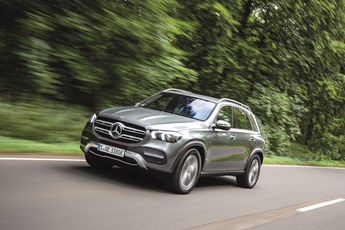We use cookies to ensure that we give you the best experience on our website. If you continue without changing your settings, we will assume that you are happy to receive all cookies on the Business Car website. However, if you would like to, you can change your cookies at any time

The start point for the best source of fleet information |
First drive: Mercedes-Benz GLE plug-in hybrid
Date: 22 February 2021 | Author: Simon Harris

|
|
||||||||||||||||
A couple of years ago, it would have been hard to imagine being able to drive a large SUV with plug-in hybrid power delivering the same level of BIK tax as a small hatchback.
Such has been the progress in battery technology and vehicle packaging that there are now substantial cars that appeal to company directors, and will see them paying extremely low rates of tax.
Plug-in hybrid large SUVs have been on sale for a while, but have struggled to muster more than 20 miles of EV range and, as a result for many, CO2 emissions have not been dramatically low.
We're reaching the stage where battery chemistry and density are delivering huge improvements in the distance plug-in hybrid cars are able to travel on electricity. And, the way in which BIK tax is calculated for company cars, there are significant benefits for drivers in vehicles that have an EV range in excess of 40 miles.
The downside, of course, is that in a large car with a battery that requires a lot of energy, it takes longer to charge to full. And if it's done on a standard three-pin plug, it could be several hours or an overnight job.
But with many manufacturers offering a home charger deal on purchase of a plug-in model or an alternative of funding electricity at public chargers for a year and similar incentives, it's now more tempting than ever for company directors to give up their diesel large SUVs or executive cars for a plug-in hybrid.
A year ago, BMW introduced its second-generation plug-in hybrid system in the X5. The X5 45e XDrive was capable of travelling 54 miles on electric power alone, according to WLTP figures. And, suddenly, a £60,000-plus large SUV with no worries about range anxiety was available with BIK tax at 6% for 2020/21, rising to 7% from April 2021.
In the second half of 2020, Mercedes-Benz launched its second-generation plug-in hybrid system in the GLE, its big rival for the X5, with a diesel engine (unlike the BMW) and a plug-in range of more than 60 miles. BIK tax rates tell a similar story.
Mercedes-Benz is unique at the moment in pairing petrol or diesel engines with its plug-in hybrid models, depending on what they feel is most appropriate, and company bosses also point to the habit of some drivers of ignoring charging regimes. They say if the car has a clean diesel engine, at least they won't be burning so much fuel when the engine is running on too many journeys.
Driver discipline, of course, is an area where the employer can play a role and encourage responsible behaviour.
Our GLE 350de test car used a 194hp version of Mercedes-Benz's 2.0-litre diesel engine plus a 136hp electric motor. Both systems combined produce a maximum of 320hp, so performance is never a problem.
The GLE's interior is typical modern Mercedes-Benz, with widescreen displays for instruments and infotainment, high quality leather, and elegant looking design.
If the BMW X5 hybrid began to transform this sector at the beginning of 2020, Mercedes-Benz has certainly moved the game on further.
Mercedes-Benz GLE 350de AMG Line Premium
P11D: £69,975
Residual value: 41%
Depreciation: £41,321
Fuel: £1,035
Service, maintenance and repair: £4,499
Cost per mile: 78.1p
Fuel consumption: 313.1mph
CO2 (BIK band): 22g/km (7%)
BIK 20/40% a month: £82/£163
Boot space: 490 litres
Engine size/power: 1,950cc/320hp
Verdict |
8/10 |
|||
 |
|
 |
|
|











